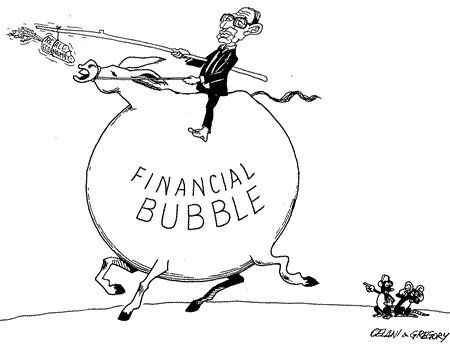$11 Trillion Commercial Real Estate Bubble Quaking
July 2017
View full size
Free market and deregulation ideologues like Alan Greenspan guide the economy with carrots and sticks. Instead of calling for the government to direct credit into new infrastructure platforms based on the most advanced technologies that massively increase the productive power of labor, inspiring people to take pride in their work with a bold vision for their future, they call for extortion of money or marketable products and services from people by means of rewards and punishments, as if people were beasts like horses. The result is financial bubbles and poverty. |
July 24, 2017 (EIRNS)—Rising default rates are shaking the commercial real estate (CRE) part of the U.S. corporate debt bubble; CRE is an $11 trillion bubble when commercial mortgage-based securities (CMBS) are included.
The top 20 trans-Atlantic banks ($100 billion or more assets) hold $1.4 trillion of these assets, most of which are CMBS securities, not the properties. The default rate on CMBS, according to Moody’s Ratings Agency, was 4.6% in September 2015; 5.6% in September 2016; and reached 6.4% in June 2017.
For the entire $14 trillion U.S. corporate debt bubble, which has doubled in size in just seven years since the securitized mortgage debt crash, the default rate has reached 2.6%. This may not seem high, but it is triple the rate of late 2015; the highest this rate reached in the collapse of 2008-09 was 4.2%.
A financial newsletter, the Chapman Report, reports that total debt in the U.S. economy (household, business, and government debt) has reached 375% of GDP and is growing four times faster than GDP (in the UK, that ratio is 600%!). "Trouble is on the horizon," the report says. "Delinquencies are rising, particular on commercial and industrial loans but also on consumer loans in North America and the EU."
Mass conversion to renting since the 2008 crash has worsened the CRS debt bubble. The Pew Research Center, based on Census data, reported that since 2006, the number of homeowning households has declined from 76.1 million to 75 million; the number renting has jumped from 34.6 million to 43.3 million. "Millennial" households are loaded with student debt, and 65% of households headed by young adults are renting. And home prices are too high for households which lost their homes in 2005-10 to buy again. Meanwhile, rents have risen 6-7% a year for eight years, a huge rise, nearly a median doubling.
Because rents are increasingly unaffordable, the Commercial Property Price Index is falling in the past year, for the first time after zooming up since the 2008 crash. Apartment buildings are a big part of commercial real estate, and CMBS, meaning banks are vulnerable to their defaults. In the year ending June 2017, prices of mall properties fell 5%, prices of strip retail fell 4%, and prices of apartment buildings fell 3%.
